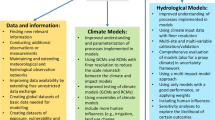Abstract
The United States is finding it difficult to develop a coherent policy on acid rain. Despite more than a decade of scientific research and policy initiatives, no clear course of action has been identified. This article argues that what is missing is an integrated assessment of the scientific knowledge that will guide the political process. The role of the integrated assessment is described, and a conceptual framework presented that would accomplish the desired goal. Currently available acid rain assessment models are compared against this framework and found to be less than satisfactory. The article concludes by stressing the opportunity now available to the National Acid Precipitation Assessment Program to perform such an assessment and break the logjam.
Similar content being viewed by others
Literature cited
Alcamo, J., L. Hordijk, J. Kamari, P. Kauppi, M. Posch, and E. Runca. 1985. Integrated analysis of acidification in Europe.Journal of Environmental Management 21:47–61.
Alcamo, J., M. Amann, J.-P. Hettelingh, M. Holmberg, L. Hordijk, J. Kamari, L. Kauppi, P. Kauppi, G. Kornai, and A. Makela. 1988. Acidification in Europe: A simulation model for evaluating control strategies.Ambio 16:232–245
Bloyd, C. N., M. J. Small, M. Henrion, and E. S. Rubin. 1988. The effects of uncertainty on the analysis of atmospheric deposition. Paper presented at the 81st Annual Meeting of the Air Pollution Control Association, June 19–24, 1988, Dallas, Texas.
Chadwick, M. J., J. G. Cooke, J. I. Kuylenstierna, R. E. Laikin, and G. B. Weber-Cooke. 1987. Acid depositions in Europe: Co-ordinated abatement strategies. Interim report from the Beijer Institute Centre for Resource Assessment and Management, University of York, UK, 86 pp.
Cowling, E. B. 1982. Acid precipitation in historical perspective.Environmental Science and Technology 16:110A-123A.
Derwent, D. 1988. A better way to control pollution.Nature 331:575–578.
EPRI (Electric Power Research Institute). 1982. Acid deposition: Decision framework. EPRI report EA-2540.
Ellis, J. H., E. A. McBean, and G. J. Farquhar. 1985. Chanceconstrained/stochastic linear programming model for acid rain abatement—I. Complete colinearity and noncolinearity.Atmospheric Environment 19:925–937.
Kaplan, E. (Brookhaven National Laboratory), D. S. Renne (Pacific Northwest Laboratory), D. S. Shriner (Oak Ridge National Laboratory), and D. G. Streets (Argonne National Laboratory). 1984. Unpublished information.
Marnicio, R.J., E. S. Rubin, M. J. Small, and M. Henrion. 1986. The acid deposition assessment model: An integrated framework for benefit and cost analysis. Paper presented at the Seventh World Clean Air Congress, August 25–29, 1986, Sydney, Australia.
McBean, E. A., J. H. Ellis, and M. Fortin. 1985. A screening model for development and evaluation of acid rain abatement strategies.Journal of Environmental Management 21:287–299.
National Acid Precipitation Assessment Program. 1987. Interim assessment: The causes and effects of acidic deposition. US Government Printing Office, Washington, DC.
National Research Council. 1981. Atmosphere-biosphere interactions: Toward a better understanding of the ecological consequences of fossil fuel combustion. National Academy Press, Washington, DC.
Quade, E. S. 1976. Analysis for public decisions. American Elsevier Publishing Company, New York, p. 21.
Rentz, O., H.-D. Haasis, T. Morgenstern, F. Perello-Aracena, J. Remmers, and G. Schons. 1988. Optimal control strategies for reducing emissions from energy conversion and energy use. Report prepared by the Institute for Industrial Production, University of Karlsruhe, FRG.
RMCC. 1986. Assessment of the state of knowledge on the long-range transport of air pollutants and acid deposition. Federal/Provincial Research and Monitoring Coordinating Committee of Canada.
Shaw, R. W. 1986. A proposed strategy for reducing sulphate deposition in North America—II. Methodology for minimizing costs.Atmospheric Environment 20:201–206.
Streets, D. G. 1988. A review of acid rain models for Europe. Report prepared for United Nations Economic Commission for Europe, Executive Body for the Convention on Long-Range Transboundary Air Pollution, Task Force on Integrated Assessment Modeling.
Streets, D. G., D. A. Hanson, and L. D. Carter. 1984. Targeted strategies for control of acidic deposition.Journal of the Air Pollution Control Association 34:1187–1197.
US Congress. 1980. Acid Precipitation Act P.L. 96-294 Title VII.
Watson, S. R. 1986. Modelling acid deposition for policy analysis.Journal of the Operational Research Society 37:893–900.
Watson, S. R., and C. W. Hope. 1987. ACIDRAIN: A model for analysing the costs and benefits of pollution control. Cambridge Decision Analysts, UK, 16 pp.
Young, J. W. S., and R. W. Shaw. 1986. A proposed strategy for reducing sulphate deposition in North America—I. Methodology for minimizing sulphur removal.Atmospheric Environment 20:189–199
Author information
Authors and Affiliations
Rights and permissions
About this article
Cite this article
Streets, D.G. Integrated assessment: Missing link in the acid rain debate?. Environmental Management 13, 393–399 (1989). https://doi.org/10.1007/BF01867674
Issue Date:
DOI: https://doi.org/10.1007/BF01867674




